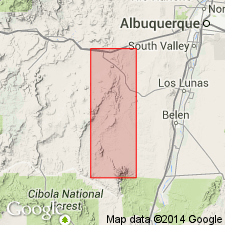
- Usage in publication:
-
- Atrasado member*
- Modifications:
-
- Original reference
- Dominant lithology:
-
- Limestone
- Shale
- Sandstone
- AAPG geologic province:
-
- Orogrande basin
- San Juan basin
Summary:
Atrasado member of Madera limestone. Thin- to thick-bedded gray to dark-gray limestone, gray and red shale, and red to light-reddish-brown and gray conglomeratic sandstone. Thickness 550 to 800 feet. Underlies Red Tanks member (new); conformably overlies Gray Mesa member (new). Age is Pennsylvanian.
[Type locality not designated.] Occupies tops of Gray Mesa [now Mesa Aparejo] and Monte de Belen. Exposed in other parts of Lucero uplift, Valencia and Socorro Cos., central NM.
Probably named from Atrasado Arroyo, [now unnamed canyon extending from approx. Lat. 34 deg. 33 min. 12 sec. N., Long. 107 deg. 13 min. 36 sec. W. to Lat. 34 deg. 34 min. 18 sec. N., Long. 107 deg. 10 min. 48 sec. W., Mesa Aparejo 15-min quadrangle], Socorro Co., central NM.
Source: US geologic names lexicon (USGS Bull. 1200, p. 168).
- Usage in publication:
-
- Atrasado Formation
- Modifications:
-
- Revised
Kues, B.S., 2001, The Pennsylvanian System in New Mexico; Overview with suggestions for revisions of stratigraphic nomenclature: New Mexico Bureau of Geology and Mineral Resources, New Mexico Geology, v. 23, no. 4, p. 103-122.
Summary:
Pg. 106-107 (fig. 3, strat. chart), 109. Atrasado Formation of Madera Group. Previously a member of Madera Limestone of Magdalena Group [use of Magdalena Group discarded] in Lucero Mesa area, central New Mexico. Now recognized in several areas along the Rio Grande. Replaces Wild Cow Formation of Madera Group in Manzano Mountains, and the informal upper arkosic limestone member of Madera Limestone in central and central northern New Mexico. Is partly equivalent to Bar B Formation of Madera Group. Overlies Gray Mesa Limestone of Madera Group. Underlies Cutler Formation, or Abo Formation, in central northern New Mexico (Nacimiento and Jemez Mountains). To south (Socorro area, Lucero uplift, and Los Pinos, Manzano, Manzanita, and Sandia Mountains) underlies Bursum Formation or Red Tanks Formation of Madera Group, or where absent, Abo Formation. In southwestern New Mexico (Robledo Mountains and Sierra Oscura) underlies Shalem Colony Formation of Hueco Group or Bursum Formation of Madera Group. Age is late Middle to Late Pennsylvanian (late Desmoinesian to Virgilian); locally in Robledo Mountains, age is Late Pennsylvanian to Early Permian (Missourian to early Wolfcampian).
Source: Publication.
- Usage in publication:
-
- Atrasado Formation
- Modifications:
-
- Principal reference
- Dominant lithology:
-
- Limestone
- Shale
- Sandstone
- Conglomerate
- AAPG geologic province:
-
- San Juan basin
Krainer, Karl, and Lucas, S.G., 2004, Type sections of the Pennsylvanian Gray Mesa and Atrasado Formations, Lucero uplift, central New Mexico: New Mexico Museum of Natural History and Science Bulletin, no. 25, p. 7-30.
Summary:
Pg. 17 (fig. 8), 18-25, 28+ (measured sections). Atrasado Formation. Gray fossiliferous limestones, and a few beds of coarse-grained pebbly sandstone and conglomerate, reddish-brown, fine-grained, cross-bedded, micaceous sandstone, and marly shale; separated by several meters of covered intervals. Total thickness about 100+/- m. Disconformably underlies Red Tanks Member of Bursum Formation; overlies Gray Mesa Formation. Age is considered Late Pennsylvanian, based on fusulinids. Type section [principal reference section] designated.
[Principal reference section] (lectostratotype): measured near Major Ranch, [north of Mesa Aparejo along Arroyo Salado], in SE/4 sec. 35 and SW/4 sec. 36, T. 6 N., R. 3 W., base at UTM Zone 13s, 306,332 m E., 3,841,602 m N., top at UTM Zone 13s, 305,897 m E., 3,842,059 m N., [approx. Lat. 34 deg. 41 min. 48 sec. N., Long. 107 deg. 06 min. 54 sec. W., Mesas Mojinas 7.5-min quadrangle], Valencia Co., central NM.
[Additional locality information from USGS historical topographic map collection TopoView, accessed May 16, 2018.]
Source: Publication.
For more information, please contact Nancy Stamm, Geologic Names Committee Secretary.
Asterisk (*) indicates published by U.S. Geological Survey authors.
"No current usage" (†) implies that a name has been abandoned or has fallen into disuse. Former usage and, if known, replacement name given in parentheses ( ).
Slash (/) indicates name conflicts with nomenclatural guidelines (CSN, 1933; ACSN, 1961, 1970; NACSN, 1983, 2005, 2021). May be explained within brackets ([ ]).

